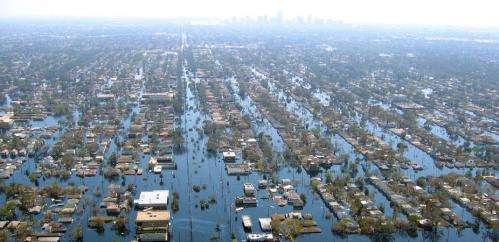Four Hiroshima bombs a second: How we imagine climate change

The planet is building up heat at the equivalent of four Hiroshima bombs worth of energy every second. And 90 percent of that heat is going into the oceans.
Right, now I've got your attention.
It's widely acknowledged that we need to keep climate change below 2C to avoid catastrophic impacts on society. To do so we need to cut greenhouse gas emissions. But this makes for tough choices for our leaders and for ourselves. Convincing people of the urgency of climate change is no mean feat.
Representing climate change and ocean warming as Hiroshima bombs attracted the attention of news media around the world.
So, when it comes to sharpening people's focus, which images have the most impact?
In a recently-released paper looking at how people visualise climate change, Saffron O'Neill at University of Exeter joined other researchers in the UK, US and Australia, to see how people engaged with climate change images drawn from mass media sources in those countries.
They investigated responses to images ranging from icons of nature, such as coral reefs, snowstorms, bushfires, cracked ground and ice sheets to human made phenomena, such as wind farms, traffic jams, low reservoirs, smoke-stacks, and fuel pumps and then images of political leaders.
For each image they wanted to measure:
1) "salience" – whether it raised the importance of climate change
2) empowerment or "self-efficacy" – the sense of being able to take any action on climate change.
Images of climate impacts were the most salient: in order of impact – flood aerial view, ice sheet, deforestation, polar bear, cracked ground, coral reef. Of the human generated images, smokestacks, traffic jams and temperature graphs led the way in terms of distress.
The least influential images of climate salience were those of politicians and celebrities, including ones who had been linked to climate action such as Bob Geldof, Prince Charles and Richard Branson.
An image of a church congregation was consistently ranked the lowest.
On the question of empowerment, solar panels, wind farms, electric cars, and home insulation led the bunch. These images related to how people could take actions to reduce emissions through personal energy choices.
In each kind of response, what stood out was the ability to relate personally to the image. Renewable technologies are an option that people can make happen in or near their own home.
Similarly, the salient flood aerial view, consistently the highest across all three countries, shows people's homes destroyed. So, unsurprisingly, what is common is that these images bring the message back to the home.
This is particularly evident with city-dwellers (the study was conducted in Melbourne, Norwich and Boulder), who have more of an urge to domesticate experiences to the dimensions of urban insularity.
For the most part, climate change as change cannot be visualised. People living in cities are the last to notice changes in climate, because it is happening a long way from our direct experience in the natural world.
But even populations that live on the land away from cities are not able to experience where most of the energy transfer is actually happening, in the oceans.
John Cook, a climate scientist based at University of Queensland teamed up with oceanographer John Church and several overseas scientists to make an astonishing calculation, which unfolds like this:
Ninety percent of the excess heat trapped in our atmosphere by greenhouse gases is actually absorbed by our oceans and ice. Without the oceans, that heat would be in our atmosphere. But because of the oceans, we can underestimate climate change.
The Cook team measured the amount of heat the oceans have absorbed in Joules. In terms of visualising warming, Joules are not very meaningful. So the team chose to convert ocean warming into a release of energy etched into the collective memory of the 20thcentury – the nuclear bomb dropped on Hiroshima.
And the maths of this is quite disturbing. The equivalent of the heat released by 345,600 Hiroshima bombs is absorbed by the earth every day, or four bombs every second. Ninety per cent of the heat released by those bombs is going into the ocean.
What Cook and his group have hit upon is that abstract climate change processes are best explained by memes, icons and social memories that make the physics involved meaningful to people. What is going on in the oceans needs to be explained using events that can be visualised, or have maybe even been experienced.
From a communication viewpoint I have begun to think about how we can extend this kind of analysis, by using extreme events and icons to get the measure of climate change.
You can multiply the heat released from the Black Saturday bushfires by 230 to get the energy absorbed into the ocean per day.
Or you can go even more nuclear to discover that the entire world stockpile of 24,300 nuclear weapons (2009 figures) is 25,000 Hiroshomas short of the daily global warming, but closer to the amount being absorbed by the oceans alone.
If these images are too difficult to imagine, we can go to pop culture itself. The Terminator films keep referring back to Judgement Day, where self-aware machines take control of nuclear weapons to extinguish 3 billion human lives. In the films future soldiers are sent back in time to prevent Judgement Day, kind of like politicians pledging to return carbon emissions to 1990 levels.
But the problem with global warming is that with that much heat going into the oceans, every day is Judgement Day.
Source: The Conversation
This story is published courtesy of The Conversation (under Creative Commons-Attribution/No derivatives).
















